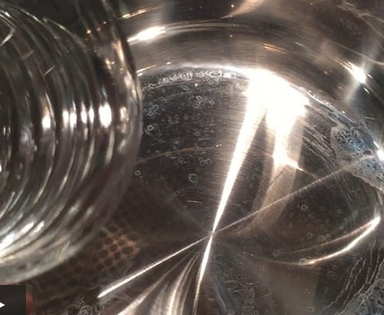Create a non-stick cooking surface

If you are trying to decrease the amount of oil you use in your cooking, you might want to try a dry saute. The trick of a dry saute is preparing the cooking surface. When a cool pan is heating up the molecules of the surface are expanding and contracting and if you place your food in too early, those molecules will "grab" on to the food, causing it to stick. In order to have a successful dry saute, you'll need to first, have a uniformly heated cooking surface and second, remember to continually stir your food.
How do you know when your surface is heated and ready for food? Easy - use the water test. Put your pan, saucer, or whatever you are cooking with over high heat. After a minute or so, drip a tablespoon or so of water in the pan. If the water simply sizzles, it is not ready.
Wait another couple of minutes and try again. If the water rolls around in the pan like a mercury ball, you're set to go. Remember to pull the heat down to medium-high to after adding your vegetables in as you typically don't need a high heat to begin cooking.
If your food does begin to stick a little, simply add a tablespoon of water or vegetable broth and keep things moving around in the pan with a spatula. This dry method is a great way to condense flavors and keep calories and fat lower in your meals.
Tagged Under:
What do you think?
Leave a Reply
Post Archive
-
2024
-
December
-
August
-
May
- THE DOC AND CHEF SHOW EP. 22: SUPER FOODS FOR BREAST CANCER PREVENTION // SUPPORTING SCIENCE AND THE RECIPE
- The Doc & Chef Present the Air Force Lifestyle & Performance Medicine Summit
- THE DOC AND CHEF SHOW EP. 21: MAKE FATTY LIVER DISEASE NACHO PROBLEM // SUPPORTING SCIENCE AND THE RECIPE
- THE DOC AND CHEF SHOW EP. 20: BOOST YOUR COLLAGEN...AND LOOK GOOD DOING IT! // SUPPORTING SCIENCE AND THE RECIPE
- THE DOC AND CHEF SHOW EP. 19: TURMERIC TO THE RESCUE // SUPPORTING SCIENCE AND THE RECIPE
- THE DOC AND CHEF SHOW EP. 18: YOUR FRIENDLY NEIGHBORHOOD OXALATES // SUPPORTING SCIENCE AND THE RECIPE
- THE DOC AND CHEF SHOW EP. 17: ANTI-NUTRIENTS ARE NOT THE ANTI-HERO!! // SUPPORTING SCIENCE AND THE RECIPE
- THE DOC AND CHEF SHOW EP. 16: PLANTS HAVE CALCIUM? // SUPPORTING SCIENCE AND THE RECIPE
- THE DOC AND CHEF SHOW EP. 15: ALZHEIMER'S DISEASE DE-MYSTIFIED // SUPPORTING SCIENCE AND THE RECIPE
-
January
-
-
2023
-
November
-
October
-
September
-
August
-
July
- THE DOC AND CHEF SHOW EP. 8: KILLER FATS AND MAGICAL AIR FRYING // SUPPORTING SCIENCE AND THE RECIPE
- THE DOC AND CHEF SHOW EP. 7: UNBLOCKING THE TRUTH ABOUT CONSTIPATION // SUPPORTING SCIENCE AND THE RECIPE
- THE DOC AND CHEF SHOW EP. 6: THE NOT SO SWEET TRUTH ABOUT SUGAR // SUPPORTING SCIENCE AND THE RECIPE
- THE DOC AND CHEF SHOW EP. 5: WHAT'S UP WITH ALL THE SALT: HOW MUCH DO WE REALLY NEED? // SUPPORTING SCIENCE AND THE RECIPE
- THE DOC AND CHEF SHOW EP. 4: GOODBYE ERECTILE DYSFUNCTION // SUPPORTING SCIENCE AND THE RECIPE
- THE DOC AND CHEF SHOW EP. 3: CANCER FIGHTING FOODS // SUPPORTING SCIENCE & THE RECIPE
-
June
-
May
-
April
- THE DOC AND CHEF SHOW EP. 2: SOY // SUPPORTING SCIENCE & THE RECIPE
- THE DOC AND CHEF SHOW EP. 1: PROTEIN // SUPPORTING SCIENCE & THE RECIPE
- Medication Deprescribing Among Patients With Type 2 Diabetes: A Qualitative Case Series of Lifestyle Medicine Practitioner Protocols
- THE DOC AND CHEF ARE LIVE IN FAIRFAX!
- 5 WAYS TO ADD MORE PLANTS TO YOUR PLATE
- POP UP EXAM ROOM PODCAST AT THE SHOP!
- Kirkwood City Lifestyle Magazine
- Forks Over Knives New Year ReSet
- FIBER FORMULA FOR WEIGHT LOSS
-
-
2022
-
December
-
October
-
September
-
August
-
July
-
June
-
May
-
April
-
March
-
February
-
January
-
-
2021
-
November
-
September
-
August
-
July
-
June
-
February
-
January
-
-
2020
-
2019
-
2018
-
December
-
July
-
May
-
April
-
February
-
-
2017
-
November
-
August
-
July
-
June
-
April
-
March
-
February
-
-
2016
-
December
-
October
-
August
-
July
-
April
-
March
-
January
-
-
2015
-
December
-
November
-
October
-
September
-
August
-
July
-
June
-
May
-
April
-
February
-
January
-
-
2014
-
December
-
October
-
July
-
June
-
April
-
February
-
January
-
-
2013
-
November
-
October
-
September
-
August
-

